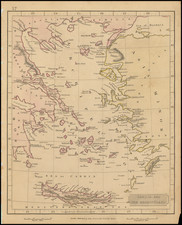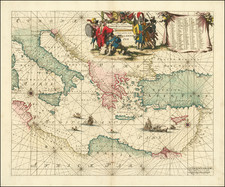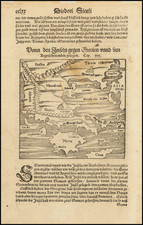Scarde battle scene view showing the Venetian seige of Turkish contolled Napoli di Roman (Nafplion) in August 1686, under the leadership of Captain General Francesco Moresini. This Morean port on the Gulf of Argos was at te time and important stop on the trade route between Venice and Constantinople and would later become the first capital of the Kingdom of Greece.
The view shows the Venetian siege of the Castel da Mer (Bourtzi) and the fortified town by bombardment from Mount Palamidi, along with the Turkish forces on the far side of the mountain and various other engagements. The view is ringed by emblematic symbols, including the Lion of San Marco.
Nafplion originally fell to the Venetians in the late 14th century. It was later controlled by the Turks from 1540 to 1686. The present view show the Venetians retaking Napflion, which they held until 1715, when it was retaken again by the Tuks. Finally, the Greeks retook control of the City in 1822, at which time it became the first capital of the Kingdom of Greece.
Vincenzo Maria Coronelli (1650-1718) was one of the most influential Italian mapmakers and was known especially for his globes and atlases. The son of a tailor, Vincenzo was apprenticed to a xylographer (a wood block engraver) at a young age. At fifteen he became a novice in a Franciscan monastery. At sixteen he published his first book, the first of 140 publications he would write in his lifetime. The order recognized his intellectual ability and saw him educated in Venice and Rome. He earned a doctorate in theology, but also studied astronomy. By the late 1670s, he was working on geography and was commissioned to create a set of globes for the Duke of Parma. These globes were five feet in diameter. The Parma globes led to Coronelli being named theologian to the Duke and receiving a bigger commission, this one from Louis XIV of France. Coronelli moved to Paris for two years to construct the King’s huge globes, which are 12.5 feet in diameter and weigh 2 tons.
The globes for the French King led to a craze for Coronelli’s work and he traveled Europe making globes for the ultra-elite. By 1705, he had returned to Venice. There, he founded the first geographical society, the Accademia Cosmografica degli Argonauti and was named Cosmographer of the Republic of Venice. He died in 1718.











![The Severn or Channel of Bristol [with a chart of the Irish Sea.]](https://storage.googleapis.com/raremaps/img/small/47485.jpg)
![La Dimostratione Del Luogo Dove Al Presente Sitrova L'Armat Di Barbarossa, et De Christiani Detto Il Golfo Dell' Artha Antichamente Il Seno Ambracio Da Ambracia Citta Reale Di Pulrrho Vicino Al Promontorio Actio Per Lavictoria Di Augusto Contra Marc Antonio et Cleopatra Memorabile [The Demonstration of the Place Where the Fleet of Barbarossa is Currently Located, and of the Christians, Called the Gulf of Artha, in the Past the Ambracian Gulf, from Ambracia, a Royal City of Pyrrhus, Near the Promontory of Actium, Memorable for the Victory of Augustus Against Mark Antony and Cleopatra.]](https://storage.googleapis.com/raremaps/img/small/73923.jpg)
![[Rhodes and Stanchio, Greece] Rhodus / Stanchio](https://storage.googleapis.com/raremaps/img/small/41669.jpg)
